Windows Terminal is a modern host application for different command line shells that you use, like Command Prompt, Windows PowerShell, etc. It lets you open and use different command line shells in different tabs. For example, you can use Command Prompt and Windows PowerShell in the same application, Windows Terminal by opening them in different tabs. This detailed guide shows how to open, customize and configure Windows Terminal settings.
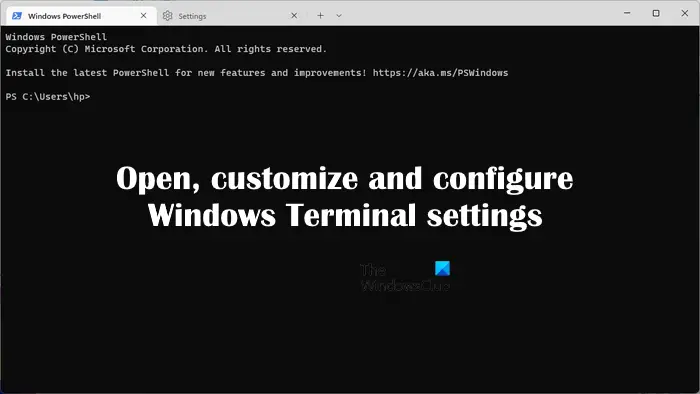
How to open, customize and configure Windows Terminal settings
Windows Terminal is available in Microsoft Store. Hence, if you do not find it on your system, you can install it from there. After installing, you can open, customize and configure Windows Terminal settings in different ways. Here, we will show you how to do that.
How to open Windows Terminal in Windows 11/10
First, let’s see different ways to open Windows Terminal in Windows 11/10. You can open it by using any of the following methods:
- Win + X or Power User menu
- Windows Search
- Run command box
- Task Manager
- Command Prompt or Windows PowerShell
- File Explorer
- By creating a desktop shortcut
Below, we have explained all these methods in detail.
1] Open Windows Terminal via Win + X or Power User menu
You can launch Windows Terminal from the Power User menu. The steps for the same are as follows:
- Press the Win + X keys or right-click on the Start button.
- Select Windows Terminal.
If you want to launch Windows Terminal as an administrator, select Windows Terminal (Admin).
2] Open Windows Terminal from Windows Search
Another way to open Windows Terminal is via Windows Search. Follow the steps provided below:
- Click on Windows Search.
- Type terminal.
- Click Terminal.
If you want to open Windows Terminal as an administrator, right-click on Terminal and select the Run as administrator option.
3] Launch Windows Terminal via the Run Command box
You can use the Run command box for different purposes, like opening different applications, reaching a particular path in File Explorer, etc. To open Windows Terminal via the Run command box, follow the instructions provided below:
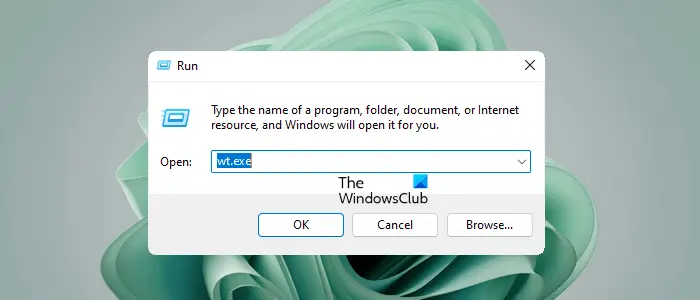
- Press the Win + R keys. The Run command box will appear.
- Type wt.exe.
- Click OK.
4] Launch Windows Terminal via the Task Manager
The Task Manager shows all the applications running on your system. You can also use it to manage startup apps. To open Windows Terminal via the Task Manager, go through the following instructions:
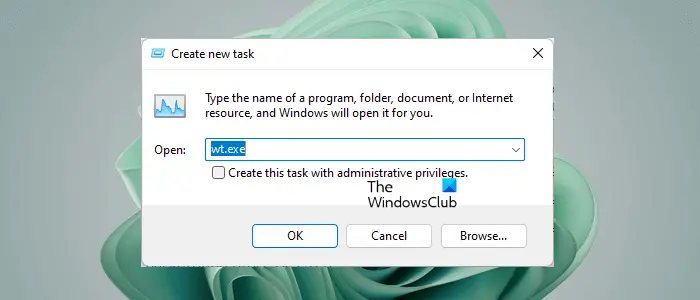
- Open the Task Manager.
- Go to “File > Run new task.”
- Type wt.exe and click OK.
If you want to open Windows Terminal with administrative rights, click the “Create this task with administrative privileges” checkbox and then click OK.
5] Launch Windows Terminal via the Command Prompt or Windows PowerShell
You can also use the Command Prompt and Windows PowerShell to open Windows Terminal. To do so, open either Command Prompt or Windows PowerShell and type wt. After that, hit Enter. Windows Terminal will appear on your screen.
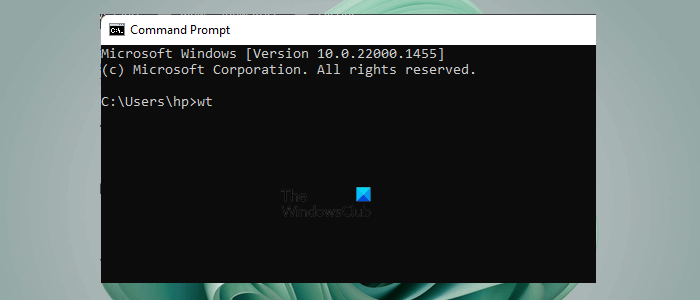
If you want to open Windows Terminal as an administrator, you have to launch the Command Prompt or Windows PowerShell as an administrator and run the same command mentioned above.
6] Open Windows Terminal from the File Explorer
The executable file of Windows Terminal is located in File Explorer. You can also launch it directly from there. By default, the Windows Terminal is located at the following location:
%LocalAppData%\Microsoft\WindowsApps
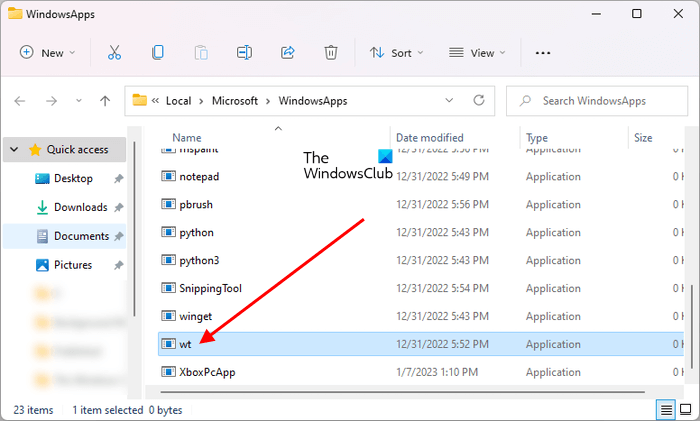
Copy the above path, open the File Explorer, and paste the copied path into the address bar of the File Explorer. After that, press Enter. This action will directly open the WindowsApps folder. Now, scroll down and look for the wt exe file. Once you find it, double-click on it to open Windows Terminal.
If you want to open it as an administrator, right-click on the wt exe file and select the Run as administrator option.
7] Open Windows Terminal by creating a desktop shortcut
You can also create a desktop shortcut for Windows Terminal so that you can launch it directly from your desktop. The following steps will help you with that:
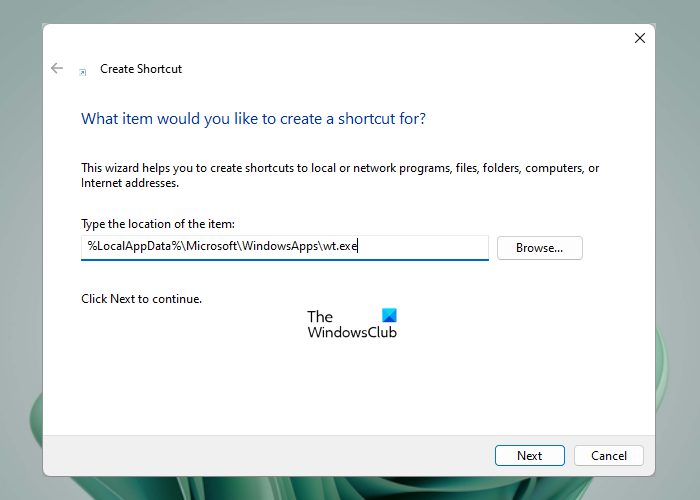
- Right-click on your desktop.
- Go to “New > Shortcut.”
- Now, copy the following path and paste it into the required field.
%LocalAppData%\Microsoft\WindowsApps\wt.exe
Now, click Next. Name the application shortcut and click Finish.
Related: How to run a Profile as Administrator in Windows Terminal.
Customize or change Windows Terminal Startup Settings
You can customize or change Windows Terminal Startup settings. The following Startup settings in Windows Terminal can be customized or changed according to a user’s interest:
- Default profile
- Default terminal application
- Launch on machine startup
- When Terminal starts
- Launch mode and other options
1] Default profile
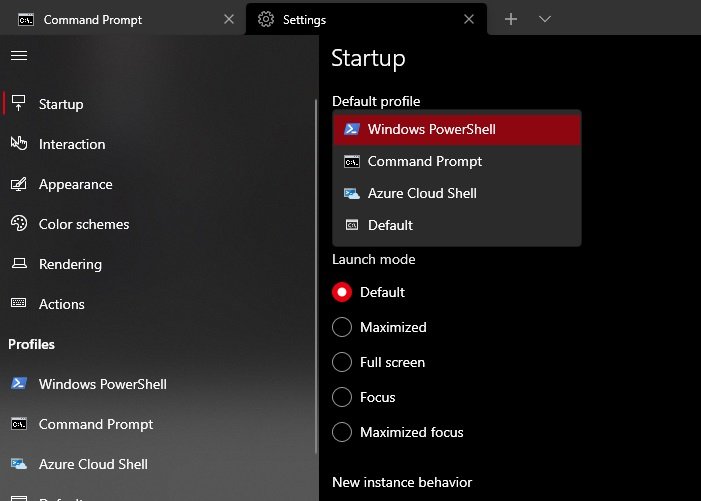
The profile that you see after opening the Windows Terminal is the default profile. On my laptop, Windows PowerShell is the default Windows Terminal profile. This can be different in your case. If you want to change this default profile, you can do so in Windows Terminal Settings.
2] Default terminal application
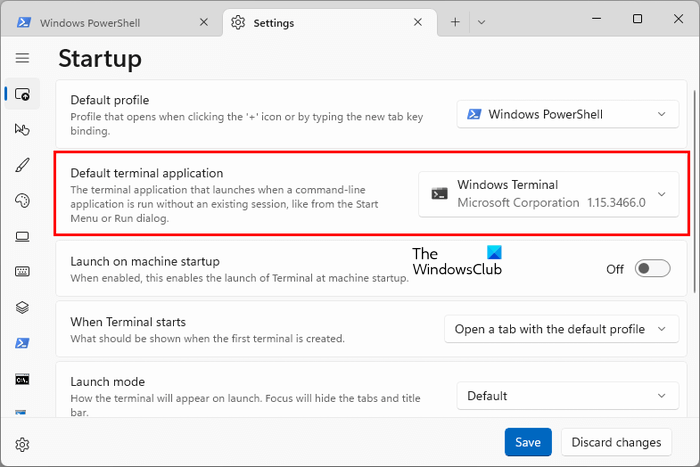
You make Windows open Command Prompt, Windows PowerShell, and other command line tools in Windows Terminal by changing this setting. By default, this option is set to “Let Windows decide.” If you leave it as is, Windows will open each command-line tool separately. For example, if you open Command Prompt or Windows PowerShell from Run or Windows Search, they will be opened in their separate windows. If you select Windows Terminal in the Default terminal application option, all the command line tools will be opened in Windows Terminal.
3] Launch on machine startup
You can turn on this setting if you want Windows Terminal to be opened automatically on system startup. By default, this option is disabled.
4] When Terminal starts
When Windows Terminal starts, it opens a tab with the default profile. For example, if Windows PowerShell is your default Terminal profile, it will be opened in a tab when you open Windows Terminal. If you want to open a tab from the previous session, you can change this setting here.
5] Launch mode and other options
You can change the default Launch mode to Maximized, Fullscreen, Focus, and Minimized focus. In addition to this, you can also change the New instance behavior and the Launch size of Windows Terminal.
Related: Disable Do you want to close all tabs prompt in Windows Terminal.
Change or configure Windows Terminal Interaction settings
You can also change or modify Windows Terminal Interaction settings. The following options are available here:
- Automatically copy selection to clipboard
- Text format when copying
- Remove trailing white-space in rectangular selection
- Remove trailing whitespace on paste
- Word delimiters
- Snap window resizing to character grid
- Tab switcher interface style
- Automatically focus pane on mouse hover
- Automatically detect URLs and make them clickable
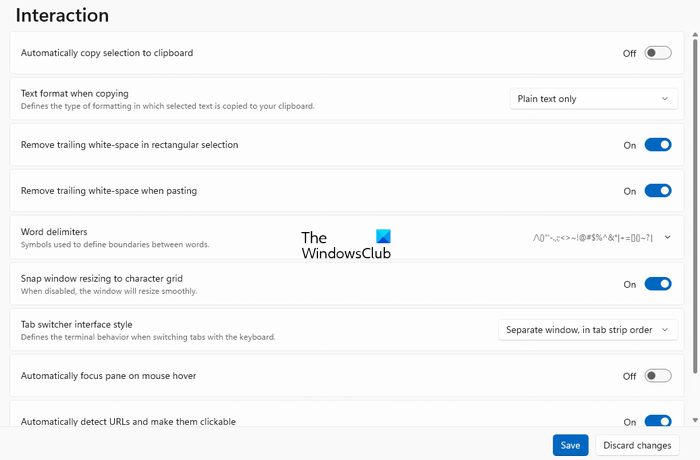
1] Automatically copy selection to clipboard
When this setting is turned on, the text you select in Windows Terminal will be copied automatically to the clipboard. By default, it is turned off.
2] Text format when copying
Here you can select the type of formatting for a text while copying it to the clipboard. If you want the text to be copied without any formatting, select the “Plain text only” option.
3] Remove trailing white-space in rectangular selection
When this setting is turned on and you copy text to the clipboard by making a rectangular selection, the trailing white spaces will be removed after each line. When it is turned off, the white-spaces are preserved, ensuring that all lines have the same length.
4] Remove trailing whitespace on paste
When this option is enabled, Windows Terminal will automatically remove trailing white space characters when you paste text to the Terminal.
5] Word delimiters
Word delimiters are the characters that specify a boundary between two words in the Terminal. Spaces, semicolons, commas, and periods are the most common examples of Word delimiters. Here you can add new or remove the existing Word delimiters.
6] Snap window resizing to character grid
When this feature is turned on, the Terminal window will snap to the nearest character boundary on resizing. If you turn it off, the Terminal window will resize smoothly.
7] Tab switcher interface style
Here you can change the Windows Terminal behavior when you switch the tabs by using the keyboard shortcut, Ctrl + Tab (forward tab switching) and Ctrl + Shift + Tab (reverse tab switching). The first two options bring an overlay window while pressing the Ctrl + Tab or Ctrl + Shift + Tab keys to switch the tabs in the Terminal.
8] Automatically focus pane on mouse hover
When you turn on this setting, Terminal will move focus on the pane on which you hover your mouse. If it is turned off, a mouse click is required to focus the pane.
9] Automatically detect URLs and make them clickable
Windows Terminal automatically detects the URLs. When you hover your mouse cursor over a URL in the Terminal, you will see that the URL is underlined. If this option is turned off, Windows Terminal will not detect the URLs automatically.
Related: How to change Starting Directory in Windows Terminal.
Customize Windows Terminal Appearance
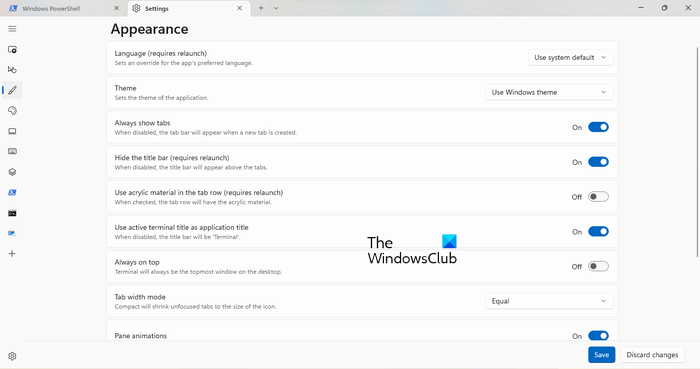
Here you can customize the appearance of Windows Terminal. The following options are available under the Appearance category in Terminal:
- Change the default Windows Terminal language. This action requires a relaunch.
- Theme: By default, Windows Terminal uses the system theme. You can change it to Light and Dark. Windows Terminal also has the option to set a custom theme. But for this, you have to edit the JSON file.
- Make Windows Terminal always show tabs, change the width of tabs, etc.
- Hide or show the Title bar.
- Turn Pane animations on or off.
- Make Windows Terminal always stay on top.
- Make Terminal always display an icon in the Notification area.
- Make the Terminal hide when you minimize it to the bottom. After turning this setting on, the Windows Terminal will be minimized to the System Tray. If this setting is turned off, Windows Terminal will be minimized to the Taskbar.
Related: How to change cursor shape for a Windows Terminal profile.
Customize Color Scheme in Windows Terminal
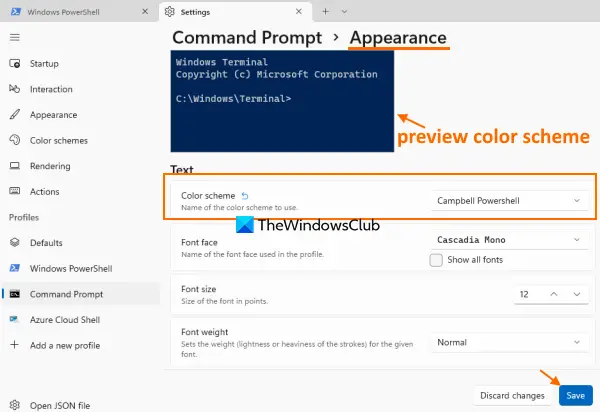
Different color schemes are available in Windows Terminal. You can change a color scheme by clicking on the respective drop-down. Terminal also has the option to add a new scheme for your profile.
Customize keyboard shortcuts in Windows Terminal
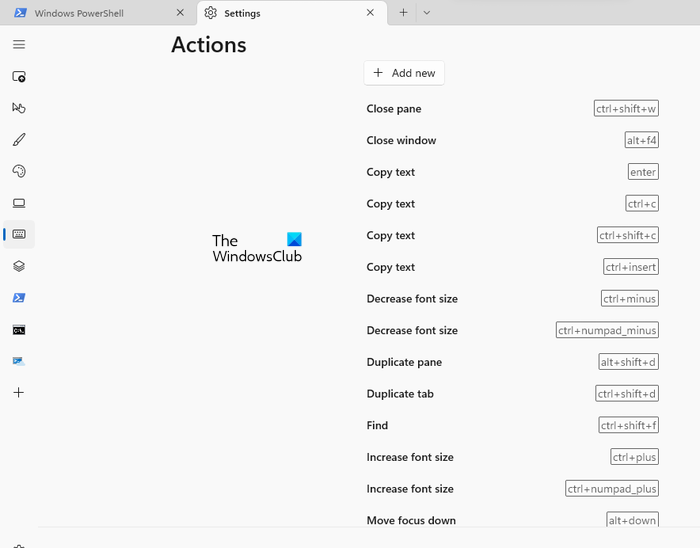
The Actions category in Windows Terminal lists the keyboard shortcuts for different actions. You can change these keyboard shortcuts by clicking on the pencil icon next to them. If you want to create a new keyboard shortcut for a new action in the Terminal, you can do so by clicking on the Add new button.
Manage Profiles in Windows Terminal
The Profiles category in Windows Terminal has the option to manage existing and create new Profiles. For every profile, you can do the following things:
- Change the profile name
- Change profile icon
- Change the tab title
- Hide a profile from the drop-down
- Make a profile always run as an administrator
- Change the profile appearance
You can also change the advanced settings for a particular profile in Windows Terminal.
Customize the Dropdown menu of Windows Terminal
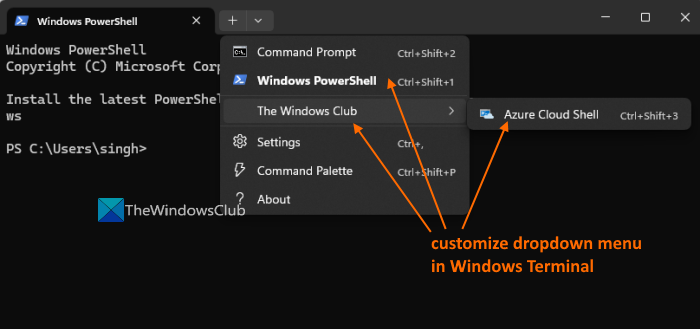
Now we can customize the dropdown menu of Windows Terminal to change the position of added profiles, add a separator, create a custom folder in the dropdown menu, and add profile(s) under that folder which is helpful for organizing the profiles in a better way. This dropdown menu customization feature has come with Windows Terminal Preview 1.17 release and it can only be done using the JSON Settings file (as of now).
Here is an example of how you can do the dropdown menu customization in Windows Terminal. Let’s say you want to change the order of profiles present in the drop-down menu to put a profile named Command Prompt on the top and a Windows PowerShell profile below that. Along with that, let’s say you want to add a separator with a folder say The Windows Club, and put Azure Cloud Shell under that folder (just like visible in the image above). For this, you need to follow these steps:
- Open the Windows Terminal
- Press Ctrl+, to open the Settings tab
- Use the Open JSON file option in the bottom-left corner
- If prompted, open the JSON Settings file in Notepad
- Look for “},” where the data related to “profiles”: section ended
- Press the Enter key and paste the following syntax:
"newTabMenu": [
{ "type":"profile", "profile": "Command Prompt" },
{ "type":"profile", "profile": "Windows PowerShell" },
{ "type":"separator"},
{
"type":"folder",
"name": "The Windows Club",
"icon": "",
"entries":[
{ "type":"profile", "profile": "Azure Cloud Shell" },
]
},
],
The syntax above includes a profile name Command Prompt that will be on the top in Windows Terminal drop-down menu, then Windows PowerShell in the second place, a separator that includes a folder named The Windows Club, and an Azure Cloud Shell profile under that folder. The image below will help you understand it more easily.
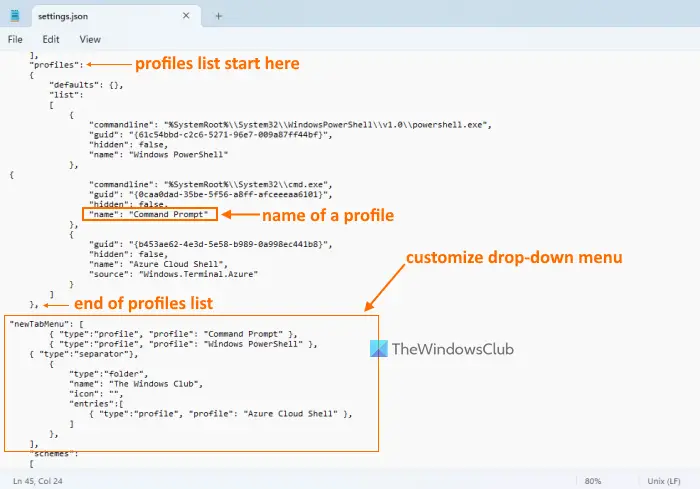
You can modify the syntax as per your requirements. Just carefully enter the correct profile names available in your JSON Settings file and make sure all the braces, commas, etc., are added properly. Otherwise, you may end up with syntax errors.
Save the changes made to your JSON Settings file. After that, open the Windows Terminal, and then access the drop-down menu to see the changes.
Related: How to reset Windows Terminal settings to default.
How to use terminal in Windows?
Windows Terminal is a cross-command line tool platform in Windows PCs which lets users use different command line tools. You can use Windows Terminal to execute commands in different tools like Command Prompt, Windows PowerShell, etc. You can also make the most used command line tool your default profile in Terminal.
How do I run a command in Windows Terminal?
Running a command in Windows Terminal is not a difficult task. First, open Windows Terminal and then open the profile in which you want to execute a command, say Windows PowerShell. Now, run the command. There is no difference in the commands that you run in Windows PowerShell separately and Windows PowerShell in Windows Terminal.
Read next: How to Export Text from a Profile in Windows Terminal.
Leave a Reply